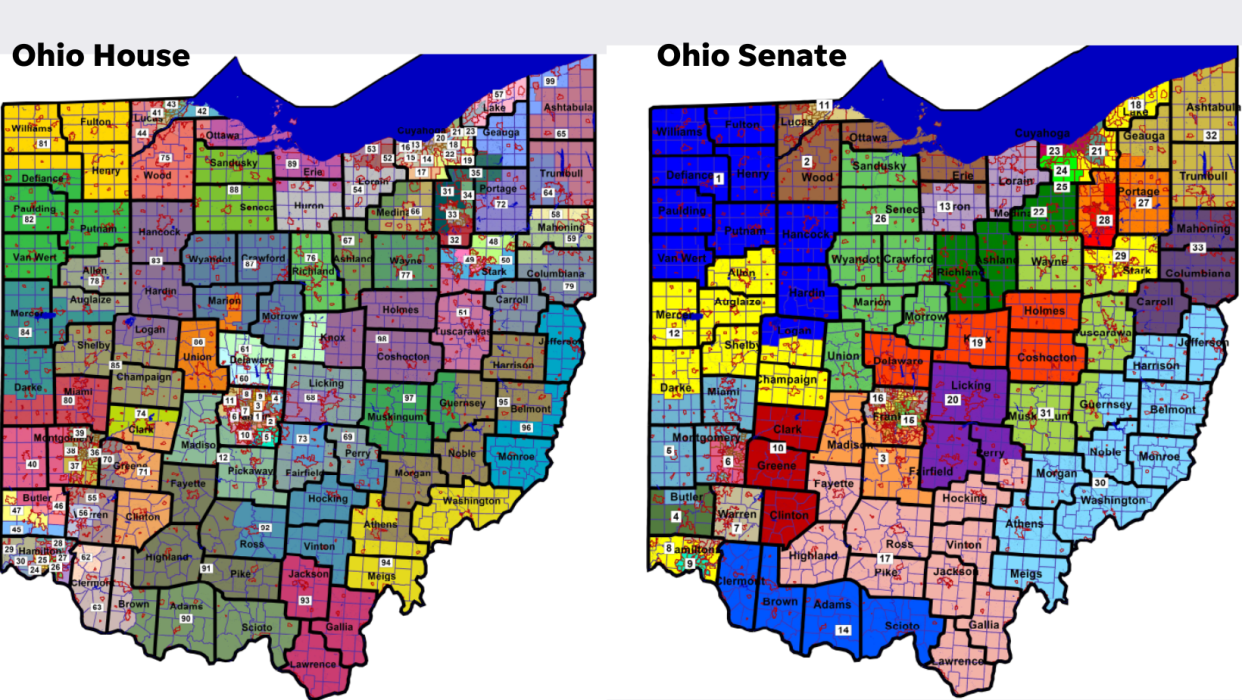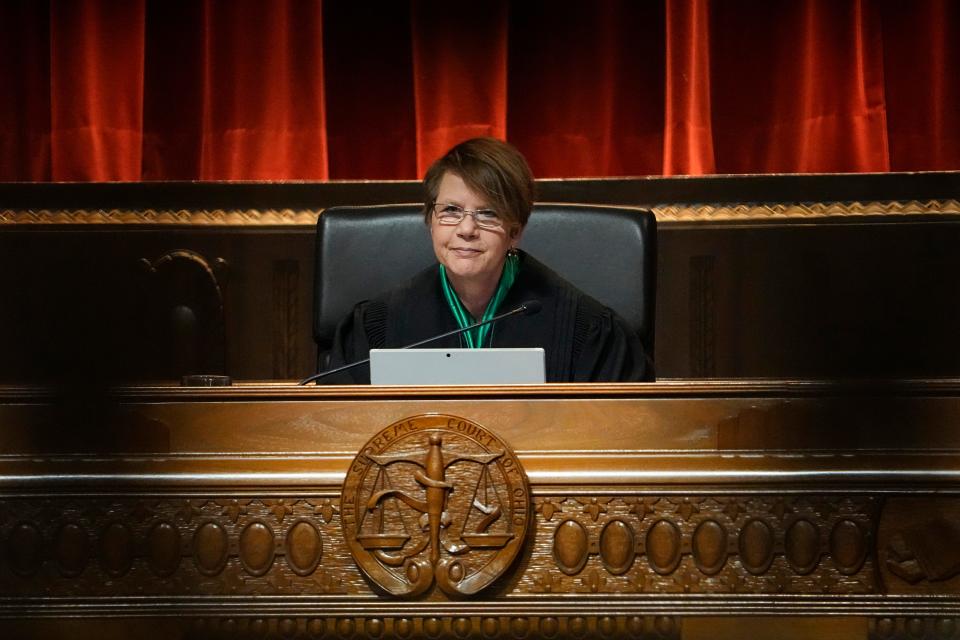Redistricting: Ohio's new maps give Republicans the edge. Democrats voted for them anyway.

- Oops!Something went wrong.Please try again later.
- Oops!Something went wrong.Please try again later.
Top Democrats at the Ohio Statehouse repeatedly said they wouldn't vote for new House and Senate maps unless Republicans gave up seats.
"Our state constitution requires and Ohioans deserve maps that give them a real pathway to political power," House Minority Leader Allison Russo, D-Upper Arlington, said at a Sept. 19 news conference. "That means that we are duty and court-order bound as a commission that closely reflects that 54% Republican, 46% Democratic partisanship of Ohio's voters in the last decade."
But the maps passed late Tuesday would favor Republicans in 62% of House seats and nearly 70% of Senate seats. Democrats voted for them anyway, likely locking them in through the 2030 elections.
The decision surprised redistricting reform advocates and some fellow Democrats.

It remains to be seen whether the bipartisan vote will undermine a proposed constitutional amendment in 2024 to replace the seven-member Ohio Redistricting Commission with a panel of 15 Ohio residents. After all, why replace a system if it worked?
“I think the process worked as it was designed and approved by the voters in 2015," Senate President Matt Huffman, R-Lima, told reporters Wednesday. “The process is ugly. People are upset, but it’s the process that we voted on and that’s how you get bipartisan buy-in."
But former GOP Ohio Supreme Court Chief Justice Maureen O'Connor, a key voice in the redistricting reform measure, had her own bipartisan message Wednesday: Neither Republicans nor Democrats could be trusted with the mapmaking pen.
“How can anybody have confidence in what the seven politicians - both Democrats and Republicans – on the Redistricting Commission have done?” O'Connor asked.
What's the balance?
Under Ohio's new maps, Republicans would be favored in 61 of 99 House seats (61.6% of districts) and 23 of 33 Senate seats (69.6%), according to data from Maptitude, a mapmaking tool used by legislative mapmakers.
Dave's Redistricting, an online mapping tool, indicates Republicans would be favored in 63 of 99 House seats (63.6% of districts) and 24 of 33 Senate seats (72.7% of districts) based on election data from 2016 to 2022. Ohio is becoming redder as Republicans win in traditional Democratic strongholds, such as Lorain County and the Mahoning Valley.
Democrats on the commission, Russo and Senate Minority Leader Nickie Antonio, say they see a path to breaking the veto-proof majority Republicans currently hold in both chambers. Republicans currently hold 67.7% of House seats and 78.8% of Senate seats, including several that favor Democrats.
"I'm pragmatic," Antonio, D-Lakewood, said Tuesday night. "We collectively produced better and fair maps for the people of Ohio and I am very hopeful that in the future, the people will help us do a better job than even we did."

Why Democrats made a deal
Democrats were negotiating from a place of weakness from the beginning.
O'Connor's departure from the Ohio Supreme Court because of age limits on judges put Democrats in a bind. They knew O'Connor's replacement, Republican Chief Justice Sharon Kennedy, would not consider Ohioans' political preferences when analyzing the maps. In her dissents, Kennedy repeatedly criticized O'Connor and Democratic justices for overstepping and operating via "judicial fiat."
Democrats were also worried about giving the mapmaking pen back to Republicans in 2025.
"My vote, quite simply, is to take this process out of the hands of this commission," Russo said Tuesday before voting for the maps. "I believe that in the future, it will be the voters who will have the final say in this and whether or not this process should remain in the hands of this commission."
Who are the winners and losers?
Mapmaking is about choices and those choices inevitably benefit some lawmakers to the detriment of others. Here are some examples:
One set of Democratic lawmakers − Reps. Phil Robinson and Richard Dell'Aquila in the Cleveland area − were drawn into the same district. They could end up facing off in a primary for that seat.
Sen. Niraj Antani, R-Miamisburg, must run for reelection in a district that favors Democrats, 54.1% to 45.8%. Antani won his 2020 race for state Senate with 53.2% of the vote, but that was under a different map that favored Republicans in that Dayton-area seat.
Democrats in the Ohio Senate have a long way to go to break the GOP's veto-proof majority. In addition to Antani's 6th District, Democrats would need to flip the 16th District in Columbus' northern suburbs (Sen. Stephanie Kunze is term-limited in 2024), 24th District in southwestern Cuyahoga County (Sen. Matt Dolan is term-limited in 2024), 13th District in Lorain and Huron counties (Sen. Nathan Manning is term-limited in 2026), 27th District in Summit, Portage and Geauga counties (Sen. Kristina Roegner is term-limited in 2026), 18th District in Lake and Cuyahoga counties (Sen. Jerry Cirino is up for reelection in 2024) and possibly the 3rd District in southern Franklin County, Pickaway and Madison counties (Sen. Michele Reynolds is up for reelection in 2026).
The safest GOP seats in the Ohio Senate are the 12th District held by term-limited Senate President Matt Huffman and the 1st District represented by his expected successor Sen. Rob McColley, R-Napoleon.
GOP Rep. Dave Dobos' 10th District, which includes Grove City and portions of Columbus, is more competitive in the final map than it was in the initial proposal.
Two Hamilton County House seats − the 27th District represented by Democratic Rep. Rachel Baker and the 28th District represented by Democratic Rep. Jessica Miranda − are among the most competitive in the state. They were slightly more Democratic in the final version than the first GOP proposal. "While I'm up for the challenge of this new map, this redistricting commission process has been a complete farce," Baker wrote on Instagram.
What comes next

Anyone can file a lawsuit with the Ohio Supreme Court challenging whether these maps follow anti-gerrymandering rules in the Ohio Constitution. Several groups that challenged past maps, including the American Civil Liberties Union of Ohio, are considering their options and will make a final decision next week.
But these same groups recently dismissed a legal challenge to Ohio's congressional map − in part because of concerns that the court's new leadership would not rule in their favor.
Meanwhile, O'Connor's group trying to amend the Ohio Constitution to replace this commission with a 15-member citizen panel is waiting to see if it cleared the first hurdle to make the November 2024 ballot.
Ohio Attorney General Dave Yost, a Republican, has until Monday to approve or deny their summary language. He has rejected two previous submissions.
Reporter Haley BeMiller contributed to this article.
Jessie Balmert is a reporter for the USA TODAY Network Ohio Bureau, which serves the Columbus Dispatch, Cincinnati Enquirer, Akron Beacon Journal and 18 other affiliated news organizations across Ohio.
Get more political analysis by listening to the Ohio Politics Explained podcast
This article originally appeared on Cincinnati Enquirer: Ohio passed new legislative maps. Who won and what comes next?

